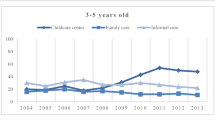Abstract
In Italy the women’s participation is among the lowest in Europe. The female employment rate stands almost 13 percentage points below the EU average and 22 below the Lisbon target. One of the most important reasons is related to the characteristics of child care system. We analyze the characteristics of the child care system in Italy and its relationship to the labor market participation decision of mothers. The two decisions are jointly considered in a discrete choice framework, which also allows for simple forms of rationing. We go on to estimate a bivariate probit model of the child care and employment decisions and find evidence that rationing is an important factor in interpreting price effects on utilization rates and employment decisions.
Similar content being viewed by others
References
Averett SL, Peters HE, Waldman D (1997) Tax credits labor supply and child care. Rev Econ Stat 79(1):125–135
Bank of Italy Survey (1998) The survey on household income and wealth. Bank of Italy
Blau DM, Robins PK (1988) Child care costs and family labor supply. Rev Econ Stat 70(3): 374–38
Boeri T, Del Boca D, Pissarides C (2005) Women at work: an economic perspective. Oxford University Press
Cannari L, Nucci F, Sestito P (2000) Geographic labour mobility and the cost of housing: evidence from Italy. Appl Econ 32(14):1899–1906
Chiuri MC (2000) Quality and demand of child care and female labour supply in Italy. Labour 14:97–118
Cigno A (1991) Economics of the family. Oxford University Press, Oxford
Cobb CD, Mitchel D, Mitchel AM (2000) Reassessing the role of child care costs in the work and care decisions of Australian families. Aust Bull Labour 26(4):197–215
Connelly R (1992) The effect of child care costs on married women’s labor force participation. Rev Econ Stat 74(1):83–90
Dehejia R, Wahba S (1999) Causal effects in non-experimental studies: reevaluating the evaluation of training programs. JASA 94(448):1053–1062
Dehejia R, Wahba S (2002) Propensity score matching methods for non-experimental causal studies. Rev Econ Stat 84:151–161
Del Boca D (1993) Offerte di Lavoro e politiche pubbliche. Roma, Nuova Italia Scientifica
Del Boca D (2002) The effects of child care and part time on the participation and fertility decisions of married women. J Popul Econ 15(3):549–573
Del Boca D, Locatelli M, Vuri D (2005) Child care choices of Italian households. Rev Econ Househ 3:453–477
Ermisch JF (1989) Purchased child care, optimal family size and mother’s employment: theory and econometric analysis. J Popul Econ 2:79–102
Ferrera M (1996) The southern model in social europe. J Eur Soc Policy 6(1):17–37
Fondazione degli Innocenti (2002) I servizi educativi per la prima infanzia. Quaderno 21
Gornick JC, Meyers MK, Ross KE (1997) Supporting the employment of mothers: policy variation across fourteen welfare states. J Eur Soc Policy 7(1):43–70
Gustafsson S, Stafford F (1992) Child care subsidies and labor supply in Sweden. J Hum Resour 2:204–229
Heckman JJ (1974) The effect of child care programs on women work effort. J Polit Econ 82(2):136–163
Heckman JJ (1979) Sample selection bias as a specification error. Econometrica 47:153–161
Heckman JJ (1993) What has been learned about labor supply in the past twenty years. Am Econ Rev Pap Proc 83(2):116–121
ISTAT (1998a) Indagine sulle forze lavoro, Italy
Jaumotte F (2003) Labour force participation of women: empirical evidence on the role of policy and other determinants in OECD countries, OECD Economic Studies 37, OECD
Jenkins S, Symons E (2001) Child care costs and lone mothers’ employment rates: UK evidence. Manch Sch 69:121–135
Kimmel J (1998) Child care costs as a barrier to employment for single and married mothers. Rev Econ Stat 80(2):287–299
Kornstad T, Thoresen TO (2002) A discrete choice model for labor supply and child care. DP 315 Statistics Norway Research Department
Kreyenfeld M, Hank K (1999) The availability of child care and mothers’ employment in West Germany. DIW Discussion Paper 191, Berlin
Meulders D, Plasman O, Plasman R (eds) (1994) Atypical employment in the EC. Aldershot, UK
OECD (2001) Employment outlook 2001, Paris
Powell L (1997) The impact of child care costs on labour supply of married mothers: evidence from canada. Can J Econ 30(3):577–594
Powell L (1998) Part time versus full time work and child care costs: evidence for married mothers. Appl Econ 30(4):503–511
Ribar D (1992) Child care and the labour supply of married women: reduced form evidence. J Hum Resour 27(1):135–165
Ribar D (1995) A structural model of child care and the labour supply of married women. J Labour Econ 13(3):558–597
Rosen S (1995) Public employment, taxes and the welfare state in sweden. NBER wp. n.5003
Rosenbaum PR, Rubin DB (1983) The central role of the propensity score in observational studies for causal effects. Biometrika 70:41–55
Viitanen T (2005) Costs of child care and female employment in england. Labour 19:149–170
Wrohlich K (2004) Child care costs and mothers’ labor supply: an empirical analysis for Germany, DIW Discussion Papers 412, German Institute for Economic Research
Author information
Authors and Affiliations
Corresponding author
Additional information
Responsible editors: Deborah Cobb-Clark & Tito Boeri
Rights and permissions
About this article
Cite this article
Del Boca, D., Vuri, D. The mismatch between employment and child care in Italy: the impact of rationing. J Popul Econ 20, 805–832 (2007). https://doi.org/10.1007/s00148-006-0126-3
Received:
Accepted:
Published:
Issue Date:
DOI: https://doi.org/10.1007/s00148-006-0126-3



